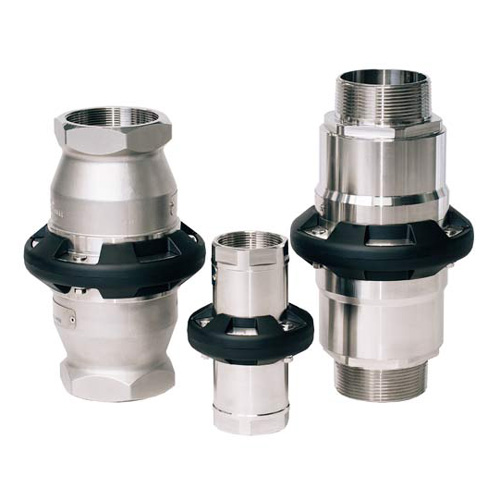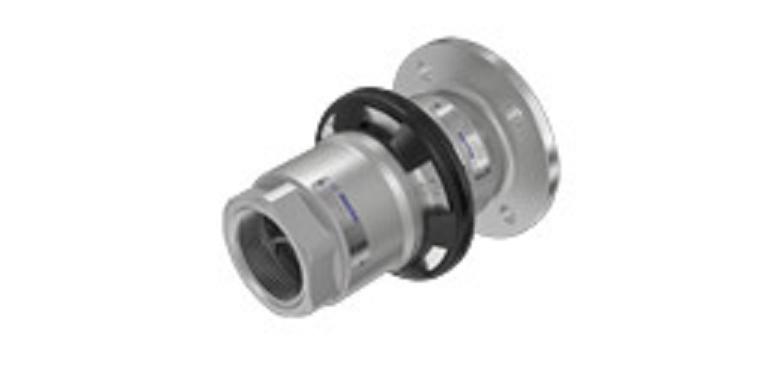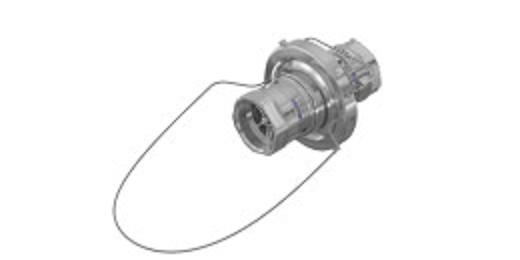
Safety Break-away couplings are used to prevent pull away accidents, protect terminal and loading/unloading equipment and eliminated unwanted product release. The break-away couplings has a diverted breaking point which will break at a determined break-load where upon the internal valves will automatically close on both sides. This will in a longer time frame minimize down time, save money, equipment and the environment.
The Safety Break-away couplings are available as Industrial and Marine type.
How it works – before and after emergency disconnect
Non-axial forces concentrate the tension forces more strongly on one bolt, so that the safety break-away coupling reacts in a natural way to the reduction of the hose break forces.

Before emergency disconnect
The safety break-away valve consists of two halves, each with a valve that has a o-ring seal.
 After emergency disconnect
After emergency disconnect
When the SBCouplings separate, it allows the valves to close. The two valves closes rapidly, minimizing exposure to
FEATURES
- Passive security against situations where a hose or loading arm could be subjected to inadvertent excessive loads.
- Design features are a simple mechanism and no loose components which could belost after release.
- Operates independently of shut off safety system and does not require an externalpower source.
- Easy to reset on site with one person High flowrate / low pressure drop
- Very low loss, positive shut-off of both coupling halves results in minimum product loss.
- Lightweight and robust design.
- Available with ANSI/DIN flanges or threaded (BSP or NPT).
Breakaway coupling with integrated shut-off valves. Used to protect hose assemblies and loading arms against excessive loads.
Designed with breaking bolts to be able to activate with a tensile force on the transfer line being applied at an angle to the plane of the coupling housing, up to 90 degrees.
Suitable for all common liquid and gaseous media in all industrial product transfer installations.
Working pressure see additional info. Temperature range -20° C up to +80° C; fulfilment of larger temperature range -50° C up to +200° C is possible – depending on medium, coupling and seal material.
Typically installed between two hose assemblies, release by axial pull only.
Breakaway coupling with integrated shut-off valves. Used to protect hose assemblies and loading arms against excessive loads. Designed with breaking bolts to be able to activate with a tensile force on the transfer line
being applied axially to the plane of the coupling housing. This coupling has additional external features that provide increased resistance to bending moment forces which may be applied to the coupling,
preventing premature activation in the unpredictable marine environment. Suitable for all common liquid and gaseous media. Typical applications include ship to offshore platform, and ship to ship product transfer operations.
Working pressure see additional info. Temperature range – 20° C up to + 80° C; fulfilment of larger temperature range – 50° C up to + 200° C is possible – depending on medium, coupling and seal material.
Typically used when a tensile force on the transfer line is not allowed or very low separation forces are required.
Additionally, release forces are almost independent from operating pressure; SBC-C are specially recommended in transfer systems with the combination of high operating pressure and weak piping structure. Breakaway coupling with integrated shut-off valves. Used to protect hose assemblies and loading arms against excessive loads.Designed with a clamp system where the tensile force is not transmitted via the hose or the loading arm but by an integrated cable which is attached to a fixed point.
After the admitted travel limit of the cable is reached (angle up to 90 degrees), only a small pull is sufficient to actuate the separation.
The necessary force is nearly independent from the internal pressure. Suitable for all common liquid and gaseous media.
Typical applications in all industrial product transfer installations Working pressure see additional info.
Temperature range – 20° C up to + 80° C; fulfillment of larger temperature range – 50° C up to + 200° C is possible – depending on medium, coupling and seal material.



